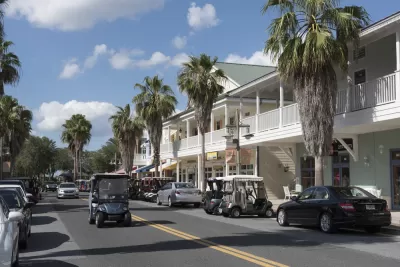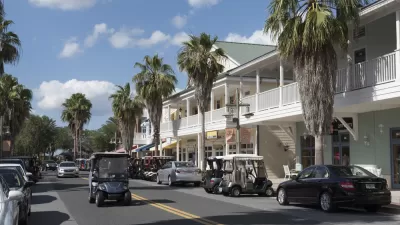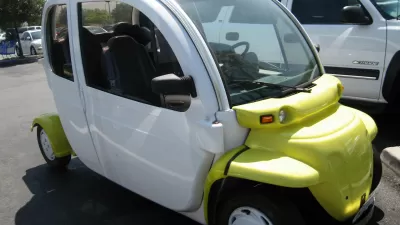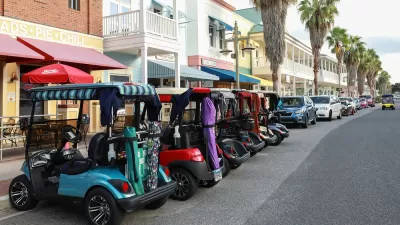Designing roads for low-speed vehicles like golf carts can make getting around safer and easier for seniors.

There is much for urbanists to critique about Florida's master-planned community the Villages–currently "the fastest-growing metropolitan statistical area in the country." But one thing the Imagineer-designed retirement community got right, argues Alissa Walker, is their enthusiastic support of golf carts as a transportation mode.
"Those golf carts, in fact, make a lot of urban-transportation planners salivate. By some estimates, one-third of all trips in the Villages are taken in them. They run on electricity, or on a little bit of non-ethanol gasoline (dispensed from old-timey pumps, even). They are lightweight and barely pollute. They’re not supposed to go faster than 20 mph, and they don’t kill many people the way cars do (although it does happen)."
Not that the Villages is any kind of car-free utopia. Ryan Erisman, author of Inside the Bubble: The Complete Guide to Florida’s Most Popular Community, says "[m]ost people still have cars" which they use for any trips outside the immediate neighborhood. Meanwhile, the Villages has no public transit to speak of. "Of course we should be working, in general, to put everything closer together so nobody has to get behind the wheel at the age of 95 — or 55, for that matter." But the concept of actively designing for golf carts or other slow-speed vehicles could go a long way toward making cities more friendly to seniors and the general population.
FULL STORY: There's One Thing We Can Learn From the Villages Success

Alabama: Trump Terminates Settlements for Black Communities Harmed By Raw Sewage
Trump deemed the landmark civil rights agreement “illegal DEI and environmental justice policy.”

Planetizen Federal Action Tracker
A weekly monitor of how Trump’s orders and actions are impacting planners and planning in America.

Why Should We Subsidize Public Transportation?
Many public transit agencies face financial stress due to rising costs, declining fare revenue, and declining subsidies. Transit advocates must provide a strong business case for increasing public transit funding.

Understanding Road Diets
An explainer from Momentum highlights the advantages of reducing vehicle lanes in favor of more bike, transit, and pedestrian infrastructure.

New California Law Regulates Warehouse Pollution
A new law tightens building and emissions regulations for large distribution warehouses to mitigate air pollution and traffic in surrounding communities.

Phoenix Announces Opening Date for Light Rail Extension
The South Central extension will connect South Phoenix to downtown and other major hubs starting on June 7.
Urban Design for Planners 1: Software Tools
This six-course series explores essential urban design concepts using open source software and equips planners with the tools they need to participate fully in the urban design process.
Planning for Universal Design
Learn the tools for implementing Universal Design in planning regulations.
Caltrans
Smith Gee Studio
Institute for Housing and Urban Development Studies (IHS)
City of Grandview
Harvard GSD Executive Education
Toledo-Lucas County Plan Commissions
Salt Lake City
NYU Wagner Graduate School of Public Service





























